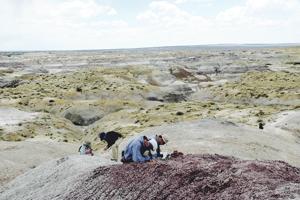A team of researchers led by Andrew Flynn, a geology professor at New Mexico State University, has made significant strides in understanding the last surviving dinosaurs before the mass extinction event that occurred approximately 66 million years ago. Their findings, published in the October 23 issue of the journal Science, challenge long-standing beliefs about the decline of dinosaur populations prior to this catastrophic event.
The research, which was a collaborative effort involving institutions such as Baylor University, New Mexico Tech, the University of Edinburgh, and the Smithsonian Institution, focuses on the Naashoibito member located in the De-Na-Zin Wilderness Area near Farmington, New Mexico. These findings suggest that the last non-avian dinosaurs in this region coexisted with famous species from the Hell Creek Formation in Montana and the Dakotas.
Implications of the Findings
Flynn’s study reveals that the dinosaurs in New Mexico were part of vibrant ecosystems. Contrary to previous assumptions of a gradual decline, the research indicates that these communities were thriving prior to the asteroid impact that is believed to have caused the mass extinction. Co-author Dan Peppe, a professor of geosciences at Baylor and Flynn’s Ph.D. advisor, noted, “These were vibrant, diverse communities.”
The New Mexico dinosaur fauna is characterized by the large, long-necked sauropod known as Alamosaurus, which is estimated to reach lengths comparable to two semi-tractor trailer rigs and weigh between 30 to 80 tons. The size of the Alamosaurus is reminiscent of a blue whale, though it is significantly lighter.
Flynn emphasized the significance of the data collected, stating, “What our new research shows is that dinosaurs are not on their way out going into the mass extinction. They’re doing great; they’re thriving.” This discovery counters the long-held perspective that a gradual decline in dinosaur diversity made them more susceptible to extinction.
New Insights into Post-Extinction Ecosystems
Another key finding from the research is the differentiation of mammalian species in the aftermath of the extinction event. The study indicated that surviving mammals retained distinct north and south bio provinces, a contrast to other mass extinction events where species tend to show more uniformity.
The researchers utilized geological techniques to date the dinosaur fossils found in northern New Mexico. By measuring the magnetic pole direction of the rocks and integrating geochemical ages of accompanying crystals, they established that these fossils from the Naashoibito member are contemporaneous with those from the Hell Creek Formation, including those of Tyrannosaurus and Triceratops.
Steve Brusatte, professor of paleontology and evolution at the University of Edinburgh and co-author of the study, remarked, “Now, in New Mexico, we have fossils of dinosaurs that were there right at the end. These were the dinosaurs that were greeted by the asteroid.” This assertion underscores the significance of accurately dating fossils to gain a clearer understanding of the extinction event.
Flynn noted that the rocks studied were deposited in the final 380,000 years of the Cretaceous period, marking them as the very last dinosaurs in New Mexico before the asteroid impact.
Looking ahead, Flynn aims to expand his research to include fossil plants from the Naashoibito member. “I’m trained as a paleobotanist,” he explained. “Finding the fossil plants there would allow us to show how different the flora was before and after the extinction in New Mexico.” Despite previous efforts to locate these fossils, he acknowledges that their absence does not preclude the possibility of their existence.
This groundbreaking study not only enhances our understanding of the final days of the dinosaurs but also opens new avenues for research into the ecological changes that followed the mass extinction event.







